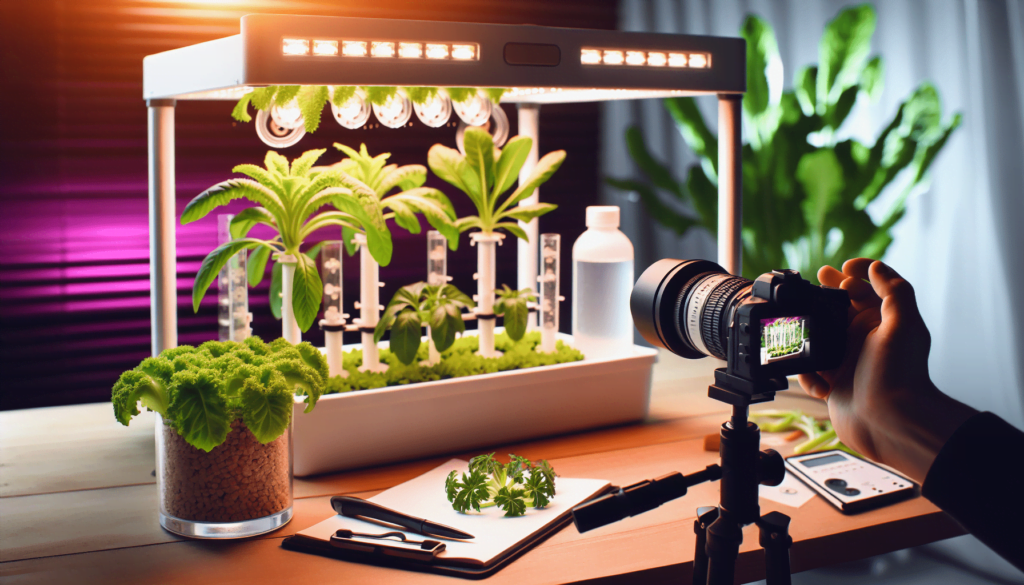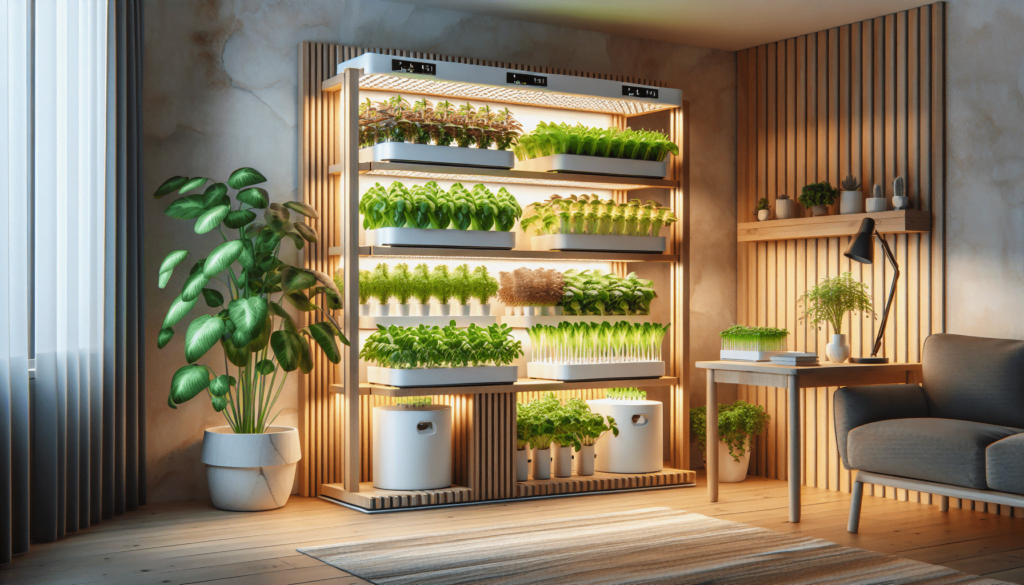With great pleasure and enthusiasm, we bring to the table a comprehensive guide titled “Mastering Hydroponics: Essential Tools for a Successful Home Project”. In the pursuit of a more sustainable and efficient way of gardening, hydroponics has taken center stage, allowing enthusiasts to grow healthy plants without soil. The article will provide you with key tools and insights necessary for a thriving home hydroponics project. With the right knowledge and equipment, we hope to help users create stunning green spaces regardless of the season or available outdoor space.

Understanding Hydroponics
When it’s time to dive deeper into gardening, we want you to consider hydroponics. Hydroponics is an innovative method of growing plants, but what exactly does it involve, and why is it beneficial?
What is Hydroponics
Hydroponics is a subset of hydroculture, which is a method of growing plants without soil, using mineral nutrient solutions in a water solvent. With this technique, we essentially allow plants to grow in a water-based environment that’s rich in nutrients. The main idea is to feed the plants precisely what they need when they need it.
Benefits of Hydroponics
One of the standout benefits of hydroponics is space efficiency. Hydroponic plants can be stacked on shelves, allowing us to grow more in the same footprint than traditional soil-based techniques. Secondly, hydroponics can produce crops all year round, regardless of the season, and is typically faster than soil-based growing. Additionally, hydroponics uses substantially less water and reduces the risk of soil-borne diseases.
Different Types of Hydroponic Systems
There are many types of hydroponic systems available, and each one has its unique benefits. These types include the wick system, the deep water culture system, the nutrient film technique, the ebb and flow system, the drip system, and the aeroponic system. The choice of system often depends on the type of plant, personal preferences, and available resources.
Setting Up Your Hydroponic System
Now, let’s walk you through how to set up a hydroponic system at home.
Choosing the Right Location
Your hydroponics system can be indoors or outdoors, depending on your preference. The key is to choose a location with good air circulation, adequate light, and stable temperatures.
Size and Layout Design
The scale of your hydroponic system depends on your space, budget, and the volume of crops you want to produce. Remember to carefully plan the layout to maximize your available space.
Hydroponic System Setup Steps
Setting up your system involves selecting the hydroponic method, installing the system, choosing the correct lighting, preparing the grow medium and nutrient solution, and finally, planting your crops.
Essential Tools for Hydroponics
Next, let’s explore the must-have tools for a fruitful hydroponic project.
Grow Lights
Light is essential for plant growth. In indoor hydroponic systems, grow lights mimic sunlight and provide the light energy your plants need to photosynthesize.
Air Stones and Air Pumps
Air pumps and air stones create bubbles that transport oxygen to the plant roots, helping them to absorb nutrients effectively.
Water Pumps
In most hydroponic systems, a water pump is essential for circulating nutrient solutions to ensure that your plants receive the nourishment they need.
Timers
Timers help regulate light sources, water pumps, and nutrient distribution, enabling automatic and efficient functioning.
pH Meters
A pH meter is crucial to monitor the acidity or alkalinity of the water, which can greatly affect nutrient absorption.
Nutrient Solution
This liquid provides the essential nutrients your plants require to grow and is a key component of any hydroponic system.
Hydroponic Trays and Reservoirs
These are used for holding the plants and the nutrient solution.
Understanding Grow Mediums
Now, let’s talk more about grow mediums, as they play a vital role in hydroponic gardening.
What are Hydroponic Grow Mediums
In soilless cultivation, plants need a substitute for soil to provide physical support and keep the roots aerated. This alternative is what we call a grow medium.
Different Types of Grow Mediums
There are various kinds of grow mediums, including rockwool, clay pellets, perlite, vermiculite, and coconut fiber, to name a few. The choice of medium can depend on the plant type and personal preference.
How to Choose the Right Grow Medium
The right grow medium depends on the hydroponic system and the type of plant you are growing. Some factors to consider include water retention, oxygen holding capacity, and pH stability.
Hydroponic Nutrients
Nutrients play a critical role in the growth and development of your plants in a hydroponic system.
Importance of Hydroponic Nutrients
Since we don’t use soil in hydroponics, it’s important to provide all essential nutrients directly to the plant’s water supply. This ensures your plants get the nourishment they need to grow and thrive.
Types of Nutrient Solutions
There are myriad nutrient solutions available, and the right one depends on your crop. Solutions typically have a mix of macro and micronutrients tailored to the needs of specific plant types.
How to Properly Use Nutrient Solutions
You should add the nutrient solution to your water reservoir and monitor it regularly. The pH and electrical conductivity should be checked and adjusted as needed to promote nutrient absorption.
Maintaining Ideal Conditions
Successfully growing plants hydroponically requires balancing several conditions.
Understanding pH Level
Maintaining the right pH level is critical. This affects how well plants can take up nutrients. Most plants prefer a slightly acidic environment.
Temperature and Humidity Control
Controlling the temperature and humidity within your hydroponic system guarantees optimal plant growth. Monitor these parameters closely to keep them within the ideal range.
Proper Light Exposure
Ensuring your plants receive the right amount and quality of light can greatly contribute to their growth. Adjust your lighting system for varying stages of plant growth.
Plant Selection and Care
Choosing the right plants for your system and taking care of them will improve your success with hydroponics.
Choosing the Right Plants for Hydroponics
Not every plant is suited for hydroponic cultivation. You must consider factors like growth habits, nutrient requirements, and light needs when choosing plants.
Planting Techniques
Proper planting techniques in hydroponic farming are crucial. These include preparing seeds or plantlets, placing them correctly in the grow medium, and caring for young plants.
Managing Plant Growth and Health
Regular monitoring of plant growth and health is essential. Look out for nutrient deficiencies, pH imbalances, pests, and diseases, and adjust conditions as necessary for optimal health.
Troubleshooting Common Problems
Here are some common issues you might encounter and how to tackle them.
Identifying Nutrient Deficiencies
If your plants aren’t growing correctly or their leaf color has changed, you might have a nutrient deficiency. Regular testing of the nutrient solution is crucial to prevent and manage deficiencies.
Managing Pests and Diseases
Just like traditional gardening, pests and diseases can be a problem in hydroponic farming. Proper sanitation and the use of appropriate pest management strategies can help control these issues.
Addressing Water and pH Issues
Maintaining stable pH and water quality is crucial. Imbalances need to be addressed promptly to prevent negative impacts on your plants.
Cleaning and Maintenance
Caring for your hydroponic setup also involves regular cleaning and maintenance.
Regular Cleaning Routines
By keeping your system and growing area clean, you can avoid most pest and disease issues. This includes cleaning the system and components between crop cycles.
Maintaining Equipment
Properly maintaining your equipment can ensure a longer lifespan and fewer system malfunctions.
Replacing Grow Mediums and Nutrients
Over time, your grow medium will lose its effectiveness and nutrients will be used up. Regularly scheduled replacement will keep your system productive.
Steps to Mastering Hydroponics
Finally, let’s share some steps to help you master hydroponics.
Learning Through Trial and Error
Like any other skill, getting good at hydroponics may take time. Don’t be discouraged by early failures.
Continual Research and Learning
Keep learning about the latest trends and techniques in hydroponics. This will help you optimize your system and improve your crops.
Connecting with the Hydroponic Community
Joining the broader community of hydroponics enthusiasts can provide a wealth of experience and advice. Whether this is through online forums or local clubs, it’s always good to share knowledge and learn from others.
By adhering to this guide, we believe you are well on your way to mastering hydroponics. Remember, every journey begins with a single step and soon enough, you’ll be reaping the fruits of your labour. Enjoy your hydroponic gardening adventure!
Forum
Got something to share or a question to ask? Jump in and start a conversation! Whether it’s tips, advice, or just sharing your experiences, we’d love to hear from you. Don’t be shy—your input could inspire or help someone else!- This forum has 1 topic, and was last updated 10 months, 2 weeks ago by .
- Topic
- Voices
- Last Post
- You must be logged in to create new topics.


